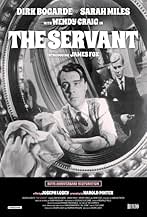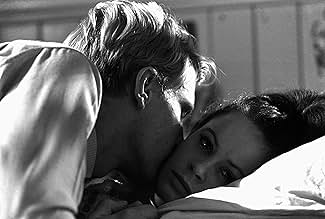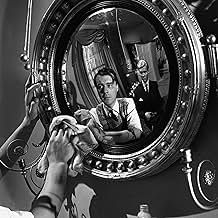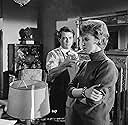IMDb-BEWERTUNG
7,8/10
15.173
IHRE BEWERTUNG
Tony aus der Oberschicht stellt den Diener Hugo Barrett ein, der, wie sich herausstellt, eine versteckte Absicht hat.Tony aus der Oberschicht stellt den Diener Hugo Barrett ein, der, wie sich herausstellt, eine versteckte Absicht hat.Tony aus der Oberschicht stellt den Diener Hugo Barrett ein, der, wie sich herausstellt, eine versteckte Absicht hat.
- 3 BAFTA Awards gewonnen
- 8 Gewinne & 11 Nominierungen insgesamt
Doris Nolan
- People in restaurant: Older Woman
- (as Doris Knox)
Empfohlene Bewertungen
About midpoint Tony's girlfriend Susan asks servant Hugo, "What do you want from this house?" It's a direct and pointed question that's ambiguously answered ("I'm just the servant, mum.")
That ambiguity carries the dramatic tension along its murky but intriguing path, as a strange play of power and manipulation unfolds. Yet after a series of quirkly developments transpire and the tables of manservant and master are reversed, what's the real gain?
What was there in the house in the first place that was worth all the fuss and bother to acquire? Satisfaction of taking over the master role?
Whatever the goal, it all seems a tawdry victory. After the shoe's on the other foot and a few points are scored in this cheesy power game, where's the spoil?
What does drive this drama is Pinter's genius for inventing small talk that gives the illusion of grandeur Losey's direction is right on the mark, and the production design, score, photography--and the acting--are all top drawer.
As in his subversive play, "The Homecoming," Pinter manages to hold the attention with his unique pregnant pauses and hypnotic ambiance, which are actually illusionary. It could be a play about something very important or about nothing.
One thing is for certain: once "The Servant" is seen, one never quite forgets it.
This remains Dirk Bogarde's defining cinematic role.
That ambiguity carries the dramatic tension along its murky but intriguing path, as a strange play of power and manipulation unfolds. Yet after a series of quirkly developments transpire and the tables of manservant and master are reversed, what's the real gain?
What was there in the house in the first place that was worth all the fuss and bother to acquire? Satisfaction of taking over the master role?
Whatever the goal, it all seems a tawdry victory. After the shoe's on the other foot and a few points are scored in this cheesy power game, where's the spoil?
What does drive this drama is Pinter's genius for inventing small talk that gives the illusion of grandeur Losey's direction is right on the mark, and the production design, score, photography--and the acting--are all top drawer.
As in his subversive play, "The Homecoming," Pinter manages to hold the attention with his unique pregnant pauses and hypnotic ambiance, which are actually illusionary. It could be a play about something very important or about nothing.
One thing is for certain: once "The Servant" is seen, one never quite forgets it.
This remains Dirk Bogarde's defining cinematic role.
Back in the late 1960's or early 70's I discovered this creepy psychological drama on local late-night TV. Once seen, it's never quite forgotten, and it's fascinating to see it once again beautifully restored and uncut in its new DVD release. Aspects of it stick with you years later, most especially the dark, moody torch song with some bizarre lyrics which is played repeatedly throughout the story on Mr. Tony's record player, seeming more sinister with each successive playing. By the time of its final hearing near the end of the movie, its effect is so oppressive that it's a relief when the record player is violently shoved off the table. One telling detail is in the scene where Mr. Tony is left alone after Barrett and Vera are expelled from the house, and his fiancee Susan also disappointedly leaves him. He dejectedly goes to an upstairs bedroom, and on the wall above the bed we see pictures of male body-builders.
The cast is uniformly excellent. This was apparently James Fox's film debut, as his credit indicates `Introducing James Fox.' He was obviously an experienced actor, though. In contrast, four years later he was affecting an American accent, singing and dancing, and amazingly, looking even younger in `Thoroughly Modern Millie.'
This is the sort of role that I always associate Dirk Bogarde with. The way Barrett's malevolent character is gradually revealed, not just through the script, but through Bogarde's facial expressions and body language, is a credit to this great actor's skill. This is one dangerous guy.
`The Servant' is a real gem of early 60's British film.
The cast is uniformly excellent. This was apparently James Fox's film debut, as his credit indicates `Introducing James Fox.' He was obviously an experienced actor, though. In contrast, four years later he was affecting an American accent, singing and dancing, and amazingly, looking even younger in `Thoroughly Modern Millie.'
This is the sort of role that I always associate Dirk Bogarde with. The way Barrett's malevolent character is gradually revealed, not just through the script, but through Bogarde's facial expressions and body language, is a credit to this great actor's skill. This is one dangerous guy.
`The Servant' is a real gem of early 60's British film.
The Servant is directed by Joseph Losey and adapted to screenplay by Harold Pinter from the novelette of the same name written by Robin Maugham. It stars Dirk Bogarde, Sarah Mles, Wendy Craig and James Fox. Music is by John Dankworth and cinematography by Douglas Slocombe.
When well-to-do Londoner Tony (Fox) hires Hugo Barrett (Bogarde) as his manservant, he gets more than he bargained for. Especially when Hugo's sister Vera (Miles) also arrives on the scene
The Servant remains as enigmatic today as it was back on its release in the early part of the 1960s. It's a film that defies classification, that rare old cinematic treat that continues to cause debate about not only its worth as art, but also its very meaning(s). A head bothering delight that revels in toying with your perceptions as much as Hugo Barrett enjoys toying with his supposed master. Lets play master and servant - indeed.
Set predominantly in the confines of Tony's swanky Chelsea abode, there's a disturbing claustrophobia that pervades the narrative, and this before we even begin to ponder the power of man, his ability to dominate and manipulate, or the reverse side that sees another's lack of ability to not succumb to the downward spiral instigated by a supposed lesser man.
Sprinkled over power issues are sexual desires, obtained, unfulfilled or simmering away unspoken. As the literate screenplay comes out in sharp dialogue snatches, breaking free of Pinter's other wise cement ensconced writing, there's evidence that this is a psychological study as opposed to the class system allegory that many thought it was way back then. This really isn't about role reversal, the finale tells us that.
Visually it's a box of atmospheric tricks as well. Losey and Slocombe use deep angular black and white photography to enforce the chilly dynamics at work in the story, the longer the film goes on, as it gets to the nitty gritty, the more jarring the camera work becomes – delightfully so – the house no longer an affluent person's residence, but a skew-whiff place of debauchery and mind transference. And mirrors - reflections, important and used to great effect.
Some scenes are striking and rich. Hugo at the top of the stairs standing in the bedroom doorway, in silhouette, an overhead shot of Hugo and Tony playing a childlike ball game on the stairs, a sex scene on a leather chair that we don't see but understand totally. And many more as Losey finds the material that allows him to show his skills.
Cast performances are across the board terrific, particularly Bogarde who gives a visual acting master class, and Fox who beautifully shifts a gear from toff twit into dependant dead beat. While Dankworth's musical accompaniments add flavour to the unfolding machinations. 9/10
When well-to-do Londoner Tony (Fox) hires Hugo Barrett (Bogarde) as his manservant, he gets more than he bargained for. Especially when Hugo's sister Vera (Miles) also arrives on the scene
The Servant remains as enigmatic today as it was back on its release in the early part of the 1960s. It's a film that defies classification, that rare old cinematic treat that continues to cause debate about not only its worth as art, but also its very meaning(s). A head bothering delight that revels in toying with your perceptions as much as Hugo Barrett enjoys toying with his supposed master. Lets play master and servant - indeed.
Set predominantly in the confines of Tony's swanky Chelsea abode, there's a disturbing claustrophobia that pervades the narrative, and this before we even begin to ponder the power of man, his ability to dominate and manipulate, or the reverse side that sees another's lack of ability to not succumb to the downward spiral instigated by a supposed lesser man.
Sprinkled over power issues are sexual desires, obtained, unfulfilled or simmering away unspoken. As the literate screenplay comes out in sharp dialogue snatches, breaking free of Pinter's other wise cement ensconced writing, there's evidence that this is a psychological study as opposed to the class system allegory that many thought it was way back then. This really isn't about role reversal, the finale tells us that.
Visually it's a box of atmospheric tricks as well. Losey and Slocombe use deep angular black and white photography to enforce the chilly dynamics at work in the story, the longer the film goes on, as it gets to the nitty gritty, the more jarring the camera work becomes – delightfully so – the house no longer an affluent person's residence, but a skew-whiff place of debauchery and mind transference. And mirrors - reflections, important and used to great effect.
Some scenes are striking and rich. Hugo at the top of the stairs standing in the bedroom doorway, in silhouette, an overhead shot of Hugo and Tony playing a childlike ball game on the stairs, a sex scene on a leather chair that we don't see but understand totally. And many more as Losey finds the material that allows him to show his skills.
Cast performances are across the board terrific, particularly Bogarde who gives a visual acting master class, and Fox who beautifully shifts a gear from toff twit into dependant dead beat. While Dankworth's musical accompaniments add flavour to the unfolding machinations. 9/10
I first watched Losey's most famous work - but not quite his best, in my opinion - on the big-screen at London's National Film Theatre in 1999, just a few months after star Dirk Bogarde's death; it's certainly one of the latter's most significant roles (along with the homosexual composer of DEATH IN VENICE [1971], perhaps his most representative), though I still feel that VICTIM (1961) is the finest film he's ever been associated with!
Even so, Bogarde's performance (recipient of the BAFTA award) is understated most of the time - which rather suits his enigmatic title character, a self-described "gentleman's gentleman" but actually harboring sinister ambitions. Interestingly, when Joseph Losey fell ill in mid-production, the directorial chores were thrust into the hands of the leading man until his recovery - who, amusingly, initially turned Losey down by saying that he "couldn't direct a bus" if his life depended on it!
While he was still some years away from the deliberate formalism that virtually characterized all his later output, Losey's style is here more controlled - for lack of a better word - than in, say, THE CRIMINAL (1960) or EVA (1962); this may have been due to the 'failure' of the latter (see my review elsewhere), or perhaps his collaboration with screenwriter (and influential playwright) Harold Pinter may have had more to do with this than anything else. Still, Douglas Slocombe's sleek black-and-white cinematography (also a BAFTA award winner) of the gloomy London settings - abetted by Johnny Dankworth's wistful score - is certainly among the film's most notable assets.
James Fox's fine performance as the usurped master of the house led him to short-lived stardom (and even copped the young actor the "Most Promising Newcomer" award at the BAFTAs); his career went on an extended hiatus some years later (which ended in the mid-Eighties) following his traumatic experience on the set of PERFORMANCE (1970), curiously enough a film dealing with a similar role-reversal situation! Though the women are subservient to the central relationship between Bogarde and Fox, both Sarah Miles and Wendy Craig serve their characters well; especially interesting is the battle of wits between the latter (as Fox's upper-class girlfriend) and Bogarde, whom she mistrusts from the get-go and is obviously proved right beyond her wildest imagination!
For a two-hour dialogue-driven film, the plot is pretty sparse - typically of Pinter, dealing in symbolism rather than presenting a straightforward narrative (despite being based on a novel by Robin Maugham) - but the tension between the various characters holds the viewer's attention all the way...though the final descent into depravity and degradation comes off as rather too abrupt and now seems more farcical than shocking (as it must have seemed at the time)! The cast also includes bit parts by two alumni of Losey's THE CRIMINAL - co-star Patrick Magee and screenwriter Alun Owen, sparring amusingly as a couple of clergymen in a bar! - as well as Pinter himself (a former actor in his own right, appearing as a 'society man' in the same scene, actually one of the very few set outside Fox's mansion).
There's a hilarious scene in which James Fox goes with Wendy Craig to visit her "mummified" high society parents. This enables Bogarde and Miles to live it up at the house during their absence. However, they cut short their visit and catch them romping about in their master's bedroom, whereupon he sacks them on the spot. This leads to the film's best scene, in my opinion: the chance meeting in a bar between Bogarde and Fox (who has, in the interim, fallen on hard times) where the Mephistophelean Bogarde paints a pitiful picture of himself which, inevitably, leads the lonesome Fox to engage his services once more. The way Losey shoots this marvelous sequence is masterly - with a minimum of camera movement and the actors strategically placed within the frame.
Trivia note: I own a British periodical from the early 80s called "The Movie" - a collection of essays strung together more or less by theme and running for an impressive 158 volumes - in which THE SERVANT was among the films chosen for a two-page critical evaluation, accompanied by a detailed synopsis and illustrated by numerous stills; I've leafed through it and read the review (written by Derek Prouse) so many times that these images from the film have become fixed in my mind and, as I lay watching, I was actively looking out for each one of them!
Even so, Bogarde's performance (recipient of the BAFTA award) is understated most of the time - which rather suits his enigmatic title character, a self-described "gentleman's gentleman" but actually harboring sinister ambitions. Interestingly, when Joseph Losey fell ill in mid-production, the directorial chores were thrust into the hands of the leading man until his recovery - who, amusingly, initially turned Losey down by saying that he "couldn't direct a bus" if his life depended on it!
While he was still some years away from the deliberate formalism that virtually characterized all his later output, Losey's style is here more controlled - for lack of a better word - than in, say, THE CRIMINAL (1960) or EVA (1962); this may have been due to the 'failure' of the latter (see my review elsewhere), or perhaps his collaboration with screenwriter (and influential playwright) Harold Pinter may have had more to do with this than anything else. Still, Douglas Slocombe's sleek black-and-white cinematography (also a BAFTA award winner) of the gloomy London settings - abetted by Johnny Dankworth's wistful score - is certainly among the film's most notable assets.
James Fox's fine performance as the usurped master of the house led him to short-lived stardom (and even copped the young actor the "Most Promising Newcomer" award at the BAFTAs); his career went on an extended hiatus some years later (which ended in the mid-Eighties) following his traumatic experience on the set of PERFORMANCE (1970), curiously enough a film dealing with a similar role-reversal situation! Though the women are subservient to the central relationship between Bogarde and Fox, both Sarah Miles and Wendy Craig serve their characters well; especially interesting is the battle of wits between the latter (as Fox's upper-class girlfriend) and Bogarde, whom she mistrusts from the get-go and is obviously proved right beyond her wildest imagination!
For a two-hour dialogue-driven film, the plot is pretty sparse - typically of Pinter, dealing in symbolism rather than presenting a straightforward narrative (despite being based on a novel by Robin Maugham) - but the tension between the various characters holds the viewer's attention all the way...though the final descent into depravity and degradation comes off as rather too abrupt and now seems more farcical than shocking (as it must have seemed at the time)! The cast also includes bit parts by two alumni of Losey's THE CRIMINAL - co-star Patrick Magee and screenwriter Alun Owen, sparring amusingly as a couple of clergymen in a bar! - as well as Pinter himself (a former actor in his own right, appearing as a 'society man' in the same scene, actually one of the very few set outside Fox's mansion).
There's a hilarious scene in which James Fox goes with Wendy Craig to visit her "mummified" high society parents. This enables Bogarde and Miles to live it up at the house during their absence. However, they cut short their visit and catch them romping about in their master's bedroom, whereupon he sacks them on the spot. This leads to the film's best scene, in my opinion: the chance meeting in a bar between Bogarde and Fox (who has, in the interim, fallen on hard times) where the Mephistophelean Bogarde paints a pitiful picture of himself which, inevitably, leads the lonesome Fox to engage his services once more. The way Losey shoots this marvelous sequence is masterly - with a minimum of camera movement and the actors strategically placed within the frame.
Trivia note: I own a British periodical from the early 80s called "The Movie" - a collection of essays strung together more or less by theme and running for an impressive 158 volumes - in which THE SERVANT was among the films chosen for a two-page critical evaluation, accompanied by a detailed synopsis and illustrated by numerous stills; I've leafed through it and read the review (written by Derek Prouse) so many times that these images from the film have become fixed in my mind and, as I lay watching, I was actively looking out for each one of them!
While this little known British classic has been badly neglected for the last thirty years or so, it shouldn't be; it is one of the most expertly realized portraits of British class warfare ever. Aside from Bogarde's (obviously) letter perfect portrayal of a sinister lower class valet with some ugly designs on his upper crust victim (well played also, by James Fox, who came to specialize in similar roles), one scene in particular stands out, and underlines beautifully the whole film's entire message. When Fox's aristocratic girlfriend (played by Wendy Craig) comes to visit, she has an amazing encounter with Bogarde. She suspects he's moving in on her boyfriend, ready to replace her in his affections. She imperiously orders him into the front room, abruptly quizzing him for his opinions on just about everything. She isn't concerned with his answers-she just enjoys ordering him around, Queen Victoria style. The effect is stunning-Bogarde clearly wants to strangle the bitch, but must restrain himself, he's only the servant after all. But he's still a man, and will get his revenge soon enough. The whole upper class system will be turned on its head. The resolution (if it can be called that) is not totally satisfying. In fact, it seems just as confused just and messy as life itself is.
Some reviewers have stated that Ms. Craig was miscast as the classy girlfriend. Not so-as she imperiously and hatefully orders the helpless servant around, her face and voice become a hateful mask of the arrogance and cruelty of British snobbery. A minor classic of its kind, somewhat dated, but still relevant and brilliantly filmed in moody black and white, and Bogarde's best moments on film.
Some reviewers have stated that Ms. Craig was miscast as the classy girlfriend. Not so-as she imperiously and hatefully orders the helpless servant around, her face and voice become a hateful mask of the arrogance and cruelty of British snobbery. A minor classic of its kind, somewhat dated, but still relevant and brilliantly filmed in moody black and white, and Bogarde's best moments on film.
Wusstest du schon
- WissenswertesWhen producer and director Joseph Losey was hospitalized with a brutal case of pneumonia for two weeks during this shoot, Dirk Bogarde continued filming assisted by minute, daily instructions over the phone from Losey's hospital bed. When Losey returned to the set, he did not re-shoot any of the script, much to the relief of cast and crew. Bogarde managed to keep the film on schedule, though he later said the experience made him determined never to direct.
- PatzerWhen Tony and Susan arrive at Tony's house in the Mercedes, with an extended visit in mind, they both go into the house and Tony leaves the car's lights on.
- Zitate
Hugo Barrett: I'll tell you what I am. I'm a gentleman's gentleman, and you're no bloody GENTLEMAN!
- VerbindungenFeatured in Stairs (1986)
Top-Auswahl
Melde dich zum Bewerten an und greife auf die Watchlist für personalisierte Empfehlungen zu.
- How long is The Servant?Powered by Alexa
Details
- Erscheinungsdatum
- Herkunftsland
- Sprache
- Auch bekannt als
- El sirviente
- Drehorte
- Produktionsfirma
- Weitere beteiligte Unternehmen bei IMDbPro anzeigen
Box Office
- Bruttoertrag in den USA und Kanada
- 45.522 $
- Eröffnungswochenende in den USA und in Kanada
- 7.859 $
- 28. Juli 2013
- Weltweiter Bruttoertrag
- 76.278 $
- Laufzeit
- 1 Std. 56 Min.(116 min)
- Farbe
- Seitenverhältnis
- 1.66 : 1
Zu dieser Seite beitragen
Bearbeitung vorschlagen oder fehlenden Inhalt hinzufügen






















